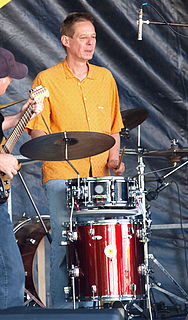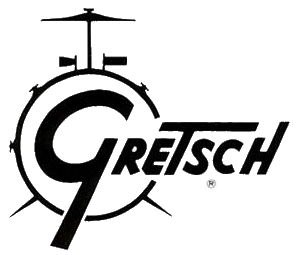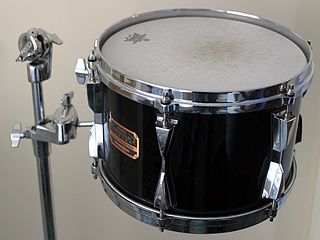
A drum set – also called a drum kit, trap set or simply drums – is a collection of drums, cymbals and other percussion instruments, which are set up on stands to be played by a single player, with drumsticks held in both hands and the feet operating pedals that control the hi-hat cymbal and the beater for the bass drum. A drum kit consists of a mix of drums and idiophones – most significantly cymbals, but can also include the woodblock and cowbell. In the 2020s, some kits also include electronic instruments. Also, both hybrid and entirely electronic kits are used.

The snare drum or side drum is a percussion instrument that produces a sharp staccato sound when the head is struck with a drum stick, due to the use of a series of stiff wires held under tension against the lower skin. Snare drums are often used in orchestras, concert bands, marching bands, parades, drumlines, drum corps, and more. It is one of the central pieces in a drum set, a collection of percussion instruments designed to be played by a seated drummer and used in many genres of music.

Carl Frederick Kendall Palmer is an English drummer and percussionist best known as a founding member of the rock supergroups Emerson, Lake & Palmer, and Asia. He has toured with his own bands since 2001, including Palmer, the Carl Palmer Band, and currently, Carl Palmer's ELP Legacy.
Tama Drums, is a brand of drum kits and hardware manufactured and marketed by the Japanese musical instrument company, Hoshino Gakki. Tama's research and development of products, along with production of its professional and most expensive drums, is done in Seto, Japan, while its hardware and less expensive drums are manufactured in Guangzhou, China. Hoshino has several offices around the world for marketing and wholesale distribution. Drums destined for the U.S. market are assembled and stocked at Hoshino (U.S.A.) in Bensalem, Pennsylvania. The U.S. subsidiary also contributes to Tama's market research and development.

Rogers Drums is an American multinational drum manufacturer. It was founded in 1849 and originally based in Covington, Ohio. During the twentieth century, their drums enjoyed popularity with musicians spanning from the Dixieland jazz era in the 1920s to classic rock in the 1960s and 1970s, but was particularly associated with big band and swing drummers of the 1940s and 1950s.

Pearl Musical Instrument Company, simply known as Pearl, is a multinational corporation based in Japan with a wide range of products, predominantly percussion instruments.
Slingerland is a United States manufacturer of drums. The company was founded in 1912 and enjoyed several decades of prominence in the industry before the 1980s. After ceasing operation in the early 1980s, Slingerland was acquired by Gibson, who briefly revived it and owned it until November 2019, before selling Slingerland to DW Drums, who have announced the intention of re-launching the brand. Slingerland is strongly associated with jazz drummers, such as Gene Krupa and Buddy Rich, who played signature instruments made by the company. Although primarily known for its drums, in the 1930s Slingerland also produced electric and acoustic guitars, violins, mandolins, banjos and ukuleles.

Drum Workshop, Inc. is an American drum kit and hardware manufacturing company based in Oxnard, California. Current products by DW include drum kits, snare drums, hardware and bass drum pedals.

Carter Anthony Beauford is an American drummer, percussionist, and founding member of Dave Matthews Band. He is known for his ability to adapt to a variety of genres, and both his ambidextrous and his open-handed drumming styles. He plays the drums and sings backing vocals in the band. Beauford was ranked number 10 by a Rolling Stone magazine reader's poll in 2010 for greatest drummers of all-time.

Jon Philip Theodore is an American drummer. He is best known as a former member of The Mars Volta and as the current drummer for Queens of the Stone Age. Theodore is also a member of One Day as a Lion.

Cocktail drums are a type of portable drum kit which combines bass drum and snare drum sounds in a single drum.

James Patrick Keeler is an American rock music drummer from Cincinnati, who best known for playing in The Greenhornes, The Raconteurs, and The Afghan Whigs. He plays with both traditional and matched grips.

Gretsch Drums is a division of American musical instrument manufacturer Gretsch. The company was founded in Brooklyn, New York, in 1883. Gretsch drum kits have been used by many notable drummers including Max Roach, Tony Williams, Art Blakey, Vinnie Colaiuta, Mark Guiliana, Phil Collins, Charlie Watts, Taylor Hawkins, Mitch Mitchell and Steve Ferrone.

Orange County Drum and Percussion is an American custom drum manufacturer located in Orange County, California. Since 2011, the company is owned by retail chain Guitar Center and only sells ready-made drum kits in set configurations that are mass-produced in China. Only artists endorsed by OCDP are allowed custom designed and manufactured kits, the most notable of which is Travis Barker who has a signature kit available for purchase.
Noble & Cooley is a US musical instruments manufacturing company based out of Granville, Massachusetts. Having been established in 1854, it is the oldest drum company of the United States and one of the oldest in the world. Having manufactured toy drums at the beginning, Noble & Cooley soon entered the professional drum market.

The Camco Drum Company is a musical instrument brand currently owned by Japanese company Hoshino Gakki. Camco was originally a drum hardware manufacturing company which began producing drums after a hostile takeover of the George H. Way drum company in 1961. Camco was active until its closure in 1977, with its assets purchased by Drum Workshop while Hoshino Gakki took over rights over the Camco name.

Drum hardware refers to the parts of a drum or drum kit that are used to tension, position, and otherwise support the instruments themselves.

A tom drum is a cylindrical drum with no snares, named from the Anglo-Indian and Sinhala language. It was added to the drum kit in the early part of the 20th century. Most toms range in size between 6 and 20 inches in diameter, though floor toms can go as large as 24 inches (61 cm). It is not to be confused with a tam-tam, a gong. The Tom is popular and used by players worldwide.
Walberg and Auge is a United States drum kit and hardware manufacturer established in 1903 in Worcester, Massachusetts by Barney Walberg. Walberg and Auge is considered by some to be, "the biggest unknown name in the history of twentieth-century American percussion." The brand is credited with several innovations in musical instruments and associated hardware including the development of the modern hi-hat stand and shell-mounted tom-tom holder. The magazine Modern Drummer detailed the origin story of the modern hi-hat configuration: "After months of experimenting, Walberg's company extended the inner rod and outer tube of his low hat stand to about waist high so he could play the cymbals with his hand as well as his feet." The pivotal innovation was sold by every major drum company under the rubric "Perfection Hats."
Drum tuning is the process of adjusting the frequency or pitch of a drum. Although most drums are unpitched instruments, they still have a fundamental pitch and overtones. Drums require tuning for a variety of reasons: to sound good together as a kit, to sound pleasing as an individual drum, to achieve the desired amount of ringing and resonance, and to produce the sound that fits the music. Some drums such as timpani and rototoms are tuned to a definite pitch. Drums are tuned by tightening or loosening the tension rods or ropes, which control the tension on the drumhead. Additional techniques such as muffling may also be used to affect resonance.















